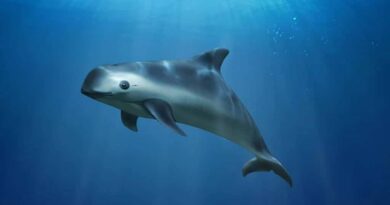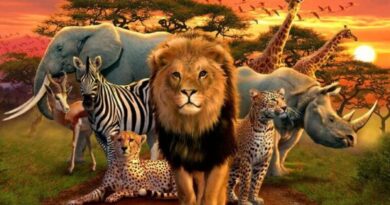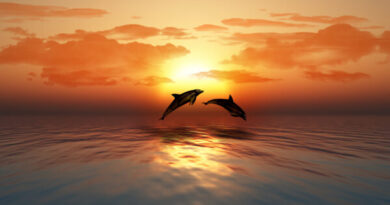The Miraculous World of Animal Reproduction: A Journey Through Nature’s Most Fascinating Phenomena
Reproduction is a fundamental process of life, ensuring the survival of species across the animal kingdom. The methods and strategies animals use to reproduce are as diverse and extraordinary as the creatures themselves. From deep oceans to towering mountains, the reproductive habits of animals reveal intricate behaviors, astounding adaptations, and profound connections. Let’s dive into the miraculous world of animal reproduction and explore some of nature’s most fascinating phenomena.
The Dance of Courtship: Wooing a Mate:
The journey of reproduction often begins with courtship, a complex dance aimed at attracting a mate. These rituals can be simple or elaborate, involving displays of color, sound, movement, and even gifts.

Birds: Masters of Courtship Displays
Birds are renowned for their courtship displays. The peacock’s resplendent tail feathers, the bowerbird’s intricately decorated nests, and the lyrebird’s mimicry of natural and artificial sounds showcase the lengths to which these avian suitors will go to win a mate. These displays serve not only to attract females but also to demonstrate the male’s fitness and genetic quality.
Insects: Chemical Romance
In the insect world, courtship often involves chemical communication. Moths, for example, release pheromones to attract mates over great distances. The male silkworm moth can detect a single molecule of the female’s pheromone from miles away, demonstrating the incredible sensitivity of these chemical signals.
Unique Mating Strategies: From the Ordinary to the Extraordinary:
Once courtship is successful, animals employ various mating strategies to ensure the continuation of their species. Some strategies are straightforward, while others are astonishingly complex.
Seahorses: Role Reversal
Seahorses present one of the most unusual examples of reproductive role reversal in the animal kingdom. In these fascinating fish, the male becomes pregnant. The female transfers her eggs to the male’s brood pouch, where he fertilizes and carries them until they hatch. This unique adaptation not only frees the female to produce more eggs but also ensures the male’s investment in the offspring’s survival.
Clownfish: Gender Fluidity
Clownfish exhibit sequential hermaphroditism, where individuals can change sex depending on their social environment. In a clownfish group, the largest and dominant individual is female, while the second largest is male. If the female dies, the dominant male will change sex and become female, while a juvenile male rises to take his place. This remarkable adaptability ensures that the reproductive needs of the group are always met.
Parental Care: Ensuring the Next Generation
The level of parental care varies widely among animals, from no care at all to extensive nurturing and protection.
Mammals: Nurturing Offspring
Mammals are known for their high level of parental care. Many mammalian mothers invest considerable time and energy into raising their young, often forming strong bonds. For example, elephant mothers are highly protective and teach their calves essential survival skills. The extended care period allows young mammals to learn complex behaviors and social structures.
Amphibians: Diverse Strategies
Amphibians display a wide range of parental care strategies. Some frogs and toads lay their eggs in water and leave them to develop independently. Others, like the poison dart frog, carry their tadpoles on their backs to safe water sources. The Surinam toad takes parental care to an extreme, with females embedding their fertilized eggs in the skin on their backs, where the young develop until they emerge as fully formed froglets.
The Miracle of Birth: Introducing New Life into the World
The culmination of the reproductive process is the birth of new life, a moment that varies dramatically across the animal kingdom.
Viviparity: Live Birth
Many animals, including most mammals, give birth to live young, a strategy known as viviparity. This method provides the offspring with a protected environment to develop, increasing their chances of survival. Live birth is not limited to mammals; some reptiles, such as certain species of snakes and lizards, also give birth to live young.
Oviparity: Laying Eggs
In contrast, oviparity involves laying eggs that hatch outside the mother’s body. Birds, reptiles, amphibians, and many fish and insects follow this strategy. Egg-laying allows parents to produce numerous offspring at once, spreading the risk and increasing the likelihood that some will survive to adulthood. Some animals, like the octopus, lay thousands of eggs but provide no care after hatching, relying on sheer numbers to ensure the survival of a few.
Conclusion: The Wonders of Reproduction
The diversity of reproductive strategies in the animal kingdom is a testament to the adaptability and resilience of life. From intricate courtship rituals to unique methods of caring for offspring, each species has evolved its own remarkable way of ensuring the continuation of its lineage. By studying these fascinating behaviors, we gain a deeper appreciation for the complexity of life and the endless creativity of nature. The miracle of reproduction, in all its varied forms, continues to inspire awe and wonder in those who take the time to observe and understand it.
FAQs:
1. Which animal has the most unique pregnancy process?
Male seahorses have the unique role of becoming pregnant. Females deposit their eggs into the male’s brood pouch, where he fertilizes and carries them until they hatch.
2. How do clownfish adapt their gender roles in a group?
Clownfish exhibit a fascinating form of gender fluidity known as sequential hermaphroditism. The dominant individual in a group is always female, and if she dies, the dominant male changes sex to become the new female, ensuring the group’s reproductive stability.
3. What determines whether an animal lays eggs or gives birth to live young?
The choice between laying eggs (oviparity) and giving birth to live young (viviparity) is an evolutionary adaptation. Oviparity often allows for a higher number of offspring at once, while viviparity offers a protected developmental environment, enhancing offspring survival.
4. What are some common ways birds attract mates?
Birds use a variety of courtship displays to attract mates, including visual spectacles like the peacock’s tail, auditory performances like the lyrebird’s mimicry, and even creating intricate structures like the bowerbird’s decorated nests.
5. How do pheromones influence animal reproduction?
Pheromones are crucial in animal reproduction, serving as chemical signals that attract mates. For example, female moths release pheromones that can be detected by males from miles away, highlighting the importance of these chemical cues in mating.
6. Is extensive parental care universal among mammals?
Not all mammals provide extensive parental care. While elephant mothers are known for their protective and teaching behaviors, other mammals might invest less time and energy, depending on their environmental needs and evolutionary strategies.
7. What are some unique amphibian parental care methods?
Amphibians exhibit a wide range of parental care. For instance, poison dart frogs carry their tadpoles to safe water sources, while Surinam toads embed fertilized eggs in their skin, allowing the young to develop there until they emerge fully formed.
8. Why are courtship rituals important in animal reproduction?
Courtship rituals are essential for mate selection, ensuring that individuals choose partners with strong genetic traits. These rituals can involve displays of strength, beauty, or other indicators of fitness and health.
9. Do any reptiles give birth to live offspring?
Yes, some reptiles, including certain snakes and lizards, give birth to live young through a process known as viviparity. This method can offer better protection and survival rates for the offspring in certain environments.
10. What is sequential hermaphroditism in animals?
Sequential hermaphroditism is when an animal changes its sex at some point in its life. Clownfish are a prime example; they start life as males and can become females if the dominant female in their group dies, maintaining reproductive balance.
11. How do mammals ensure the survival of their offspring?
Mammals employ various strategies to ensure the survival of their young, including nursing, protection from predators, and teaching essential survival skills. These extended care periods are crucial for learning complex behaviors and social structures.
12. Why do some animals provide more parental care than others?
The level of parental care varies based on evolutionary and environmental factors. Species with fewer offspring tend to invest more in each one to increase survival rates, while those with many offspring may provide less individual care, relying on quantity for species continuation.




